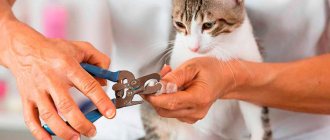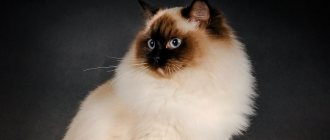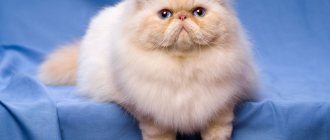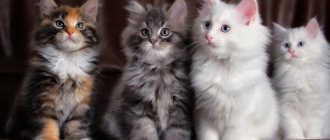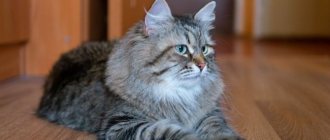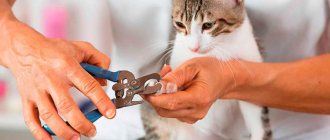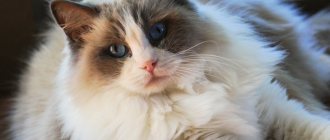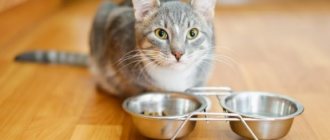See the TOP 10 most fluffy animals on earth with photos and descriptions! Nature has endowed them with thick hair; they are domestic and wild pets. Down is described as a soft and fluffy material, and in the case of animals it is usually, but not exclusively, fur or feathers. Fluffiness is often combined with cuteness and cuddliness, and this is where animal furry becomes a problem. The bear may be fluffy, but a real live bear is not cuddly. The marabou stork's lower feathers are the epitome of fluffiness, but marabou storks are ugly and ill-tempered, and few people would want to snuggle up to them. Even the Chow, one of the fluffiest domestic dogs, can be a little short-tempered.
It also seems that the furriest animals are domesticated and bred for maximum fluffiness and cuteness. But there are also wild furry animals. In this article we will look at a mix of furry animals, wild and domestic. These are animals that become furry as adults, as chicks and other babies often stop growing furry. Their down should also cover most of their body, with the exception of the marabou stork. Here are the 10 furriest animals:
No. 10. The fluffiest animals: Abyssinian guinea pig
Red Abyssinian guinea pig on green grass outside.
Although guinea pigs enjoy human affection, they should be with others of their own kind and should always be kept in pairs or small groups. A rodent kept as pets, the Abyssinian guinea pig is bred for its fluffy fur, which grows all over its body in interesting curls called rosettes. Indeed, if a guinea pig is shown, it should have an even number of these rosettes, preferably eight or 10 on certain areas of the body. Since it is difficult to find a guinea pig that meets these criteria, most Abyssinian guinea pigs are simply kept as delightful pets.
Like other furry pets, he needs a lot of grooming to keep his fur from matting and tangling. The breed is quite old and did not originate in Abyssinia, which is now called Ethiopia. It did not even originate in Guinea and is not even closely related to the pig. All guinea pigs originate from the Andean mountains of South America.
No. 9. The fluffiest animals: giant panda
Another furry, cute avatar, although an adult giant panda can weigh up to 280 pounds and stand over 6 feet tall, this beloved bear from the Chinese bamboo forest is easy to recognize. The panda's coat is primarily white, although it has the diagnostic black ears like pom-poms on its round head, small eyes surrounded by black under-eye patches, a black nose, a black shoulder saddle, and black arms and legs. In the wild it is known to eat almost nothing other than bamboo, although it has the digestive system of a carnivore and is classified as a carnivore. A lonely bear eats at sunset and dawn, and spends the rest of the day sleeping in the bamboo thickets. The good news about the giant panda is that its conservation status has been upgraded from threatened to vulnerable.
Norwegian forest
What other long-haired breeds are there? These cats are quite diverse. For example, Norwegian forest. One of the most ancient species, obtained from a wide variety of outbred cats living in northern Europe. In general, in these areas there were always quite large cats with long and thick hair. They became the progenitors of the Norwegian forest species. She really looks like a simple mongrel cat, only her face is more reminiscent of a wild jungle cat. Its color is predominantly brindle, gray-brown.
Therefore, anyone who wants to get a purebred cat and surprise their friends with it must understand that this is unlikely to happen with a forest cat. Only a specialist can distinguish it from the usual one. An elongated muzzle with large eyes set close to the nose, large ears - these are the main differences between a forest beauty and an ordinary one. The character of a representative of this species is extremely independent and freedom-loving.
Although at the same time she is quite calm, intelligent and sociable within the limits allowed by her.
No. 8. The fluffiest animals: the ruffled lemur
The black-and-white ruffed lemur is the more endangered of the two frilled lemur species, both of which are endemic to the island of Madagascar.
Like all lemurs, ruffled lemurs are native to Madagascar. It is the largest member of the Lemuridae family, measuring 39 to 47 inches in body length and weighing 7 to 9 pounds. Typically, a lemur's tail is longer than its body and can be over 2 feet in length. Its thick fluffy fur is black and white or white and red. The black-and-white lemur has a black face and may have black on its chest, sides, legs, tail, and shoulders. It also has a long dog-like snout, which shows several teeth and a claw for grooming the thick fur on its leg. The ruff goes from the ears to the chin and around the neck, like a curtain beard on the chin. Because much of its habitat has been destroyed, the lemur is critically endangered.
A ring-tailed lemur with her babies
How to choose a kitten
If you have decided to acquire a representative of the beautiful LaPerm breed, you need to carefully choose a kitten. First of all, you need to decide whether you need a Show Champion or a curly-haired four-legged companion.
If you plan to exhibit a cat in competitions, then it is advisable to choose a kitten from a good nursery or from trusted breeders. It is useful to first consult with professional felinologists and veterinarians.
If you have to choose on your own, you need to remember the following health indicators:
- behavior: a physically and mentally healthy Laperma kitten is playful, eats well, shows interest in its surroundings and communicates with the rest of the kittens in the litter;
- appearance: you should not choose both the largest and smallest kittens from the litter. All parts of the body must be proportional, movements must be natural, light and relaxed;
- appetite: kittens eat often and a lot while growing;
- hygiene: there should be no discharge from the nose, eyes, ears and from under the tail;
- damage: in large litters, small kittens can sometimes accidentally scratch each other, this is acceptable if the wounds are superficial and isolated; however, it is better when the babies are unharmed;
- condition of the parents: in addition to examining the kittens themselves, you need to evaluate their parents - whether there are any diseases, hereditary or acquired, find out their age, what kind of litter they have.
It is worth finding out what treatments were carried out against parasites, whether any vaccinations were done, and clarify the names of the drugs that were used
It is important to know what foods cats are fed to make it easier to decide on food in the future. Also, we must not forget that Laperm’s fur does not curl immediately, but no later than until he is six months old.
No. 7. The fluffiest animals: silk chicken
Also called the Chinese chicken, this bird has been bred for hundreds of years and is admired for its fluffy, deliciously soft and silky plumage. This is a small chicken, roosters weigh about 4 pounds and hens weigh 3 pounds. There are bantam breeds that are even smaller than this.
Silky chickens can be bearded or beardless. The beard consists of feathers just below the beak that covers the chicken's earlobes. Chicken also comes in several colors, including white, blue, black, gray and partridge. A champion silk should have a tiny walnut-shaped comb, blue earlobes and dark earrings. Each foot should have five toes, and the skin underneath all those fluffy feathers should be black. Despite their exotic appearance, silkies are calm and thoughtful and are often used to incubate the eggs of other birds.
No. 6. The fluffiest animals: chinchilla
This medium-sized rodent also evolved its furry fur to live in harsh climates, this time in the cold heights of the Andean Mountains in western Chile. It has been hunted and raised for its lush silver-gray fur for many years. Indeed, it has the thickest fur of any land animal. Because this fur is in demand, both species of chinchilla are considered endangered, and the short-tailed chinchilla is nearly extinct in the wild.
Chinchilla lanigera ranges from 9 to 15 inches in length, 3 to 5.5 inches in length, and weighs from 1.10 to 1.76 pounds. Chinchilla The chinchilla is 12 to 13 inches long and its tail is 5 to 6 inches long. Females are larger than males. C. chinchilla has more vertebrae in its tail than C. lanigera.
Chinchillas' sweet personalities and furry appeal make them popular as pets, but they require a lot of care. It is necessary to regulate the temperature in the room, take care of your teeth and from time to time take a dust bath with fine pumice. They are easily stressed and depressed.
plush cow
Breeders in the United States of America have developed a new cow hybrid that looks more like a giant fluffy toy than an animal. The appearance of this creature is incredibly cute due to its unusual coat, which cannot be compared with any representative of living nature. This cow appears to be more peaceful than any other breed because it is genetically unable to have horns. Females do not have an udder, so it is difficult to determine the sex of this cute stuffed cow.
What also gives her charm is the fact that an unusual thick coat grows on her legs, so they look even shorter, and the cow herself looks short and funny. The first representative of this hybrid was bred recently - just in 2013. A representative with a plush appearance became popular in a very short time, and many people became eager to have such a pet at home. For children, meeting a stuffed cow became love at first sight. But buying it is not so easy: fewer such copies are produced per year than customers crave, and for this reason the price per unit is measured in tens of thousands of dollars.
There is no need to expect significant milk yield from these animals, since their function is to touch and give pleasant tactile sensations. In order for the skin to be soft, it requires certain nutrition and ideal conditions. But this is not enough: the care program includes weekly bathing using special shampoos, conditioners, lotions, oils, mousses and foams. Regular drying will ruin the entire decorative effect, so the hairiest cows are dried using hair dryers and curlers. But even such difficulties do not stop people who want to be able to hug and cuddle this beautiful animal at home.
No. 5. The fluffiest animals: Samoyed
White Samoyed on a winter beach in the snow in the northern part of the Arctic.
In the old days, Samoyeds were the working partners of the Samoyeds of Siberia, who survived by herding and raising domestic reindeer. This service dog's fluffy white fur kept her warm as she herded reindeer in Siberia. It is a Spitz-like dog that has a long tail, as bushy as its body, and is carried curled on its back and side. Otherwise the dog is broad and muscular, its muzzle is somewhat cunning, with large dark brown eyes and thick small erect ears. He has powerful legs, a wide chest, and even his feet are covered with fur. Built for harsh weather conditions, this dog was used by Captain Robert Scott and Roald Amundsen as they explored the South Pole. The Samoyed has a shoulder height of 18 to 22 inches and weighs 50 to 65 pounds.
Breeds of long-haired cats: the beginning of history
There are two versions of the origin of long-haired cats:
- In the cold northern climate, long hair protected from frost and helped animals survive the long winter.
- Representatives of the southern regions acquired a long-haired coat to improve heat exchange - a thick layer of hair prevented the cat’s body from overheating in direct sunlight.
Later, in the 19th century, there was a great migration of cats to the European continent, where interbreeding began.
This is interesting! There are more than 250 cat breeds in the world, a third of them are long-haired animals.
No. 4. The fluffiest animals: Bichon Frize
The Bichon Frize is a double-coated breed that is always white.
The soft and dense undercoat and coarse outer coat create a soft but durable texture. This cheeky little dog has a double coat that gives him the appearance of an animated collection of cotton balls. Its fur is very soft, silky and grows in soft curls all over its body. Bred to be a companion or royalty in 15th-century Spain, this portable dog is only about a foot long from head to curly tail and weighs about 12 pounds, similar to the giant Angora rabbit.
Semi-longhair group
The Angora cat is a breed of domestic cat that was created based on cats taken from the Ankara Zoo (Turkey) in the mid-20th century. However, semi-longhaired cats, brought to Europe from the ancient Byzantine city of Angora, have been known in Europe since the 16th century. Angora cats were so popular in Europe that all white or light-colored longhaired and semi-longhaired cats were called Angoras.
The Himalayan cat is a long-haired breed similar to the Persian cat, but has a color point coat and blue eyes.
Burmese cat. One legend says that these cats were kept in the Lao Tsung Temple. The Burmese longhair cat has a medium-sized body, slightly elongated, with good proportions. Wide, rounded head with a characteristic “Roman” nose and thick cheeks.
The British Longhair is a type of British Shorthair cat. Today, the British Longhair has emerged as a full-fledged variation of the British and is becoming more and more popular every day.
Maine Coon. The exact origins of the Maine Coon are unknown. It is one of the first known breeds in North America. There are several assumptions about its origin. According to one version, Maine Coons were brought to the continent by the Vikings.
The American Bobtail is a breed of short-tailed cat, bred by North American felinologists in the second half of the last century.
The Kurilian Bobtail is a naturally occurring breed of cat on the Kuril Islands. The short-tailed cat, or Japanese bobtail, has been known in Japan for a long time. Their images can be found in many medieval engravings.
The Mekong Bobtail or Thai Bobtail is a striking breed with a short and flexible tail. However, the tail is not only short, but also has a kink. It is in this brokenness that the uniqueness of the tails of Mekong bobtails lies: each tail is one and only of its kind.
The Japanese Bobtail is a medium-sized cat with an elongated, muscular body. Graceful, very elegant, with a short tail set high. At the end of the tail there is a pompom. The hind legs are much longer than the front legs.
The Neva Masquerade cat is a long-haired cat with a color-point (Siamese) color and bright blue eyes. The Neva Masquerade cat differs from the Siberian cat only in its color.
The Norwegian forest cat is one of the oldest breeds, formed on the basis of local mongrel cats and is most widespread in the countries of Northern Europe (Norway, Sweden, Finland, etc.). The breed standard was adopted in 1976.
Ragdoll. The breed originated in California, and most likely descended from Angora and Burmese cats. Ragdolls are practically not bred outside the United States. The Ragdoll gives the impression of being a large plush toy with silky fur.
The Siberian cat is the only Russian breed of aboriginal cats, on which only nature worked. And, as with all native breeds, tracing the origins of a particular breed is often impossible.
Somali cat. In the late 50s and early 60s, American and Canadian breeders who were breeding Abyssinian cats began to find one or two dark kittens with longer hair in their offspring.
The Turkish Van or Van cat is a breed of semi-longhaired cat created from a population of randomly bred cats that originated from the area around Lake Van in the Eastern Anatolia region of modern Turkey.
Tiffany is a distant relative of the Burmese cat and Persian chinchillas. This is a surprisingly heavy, strong, stocky cat of the non-European type with a short rounded head, large expressive eyes, a strong short body, strong short limbs with rather elegant paws and long, thin, silky hair with a medium amount of undercoat, forming a frill and panties.
The Highland Fold is a Scottish Fold. Long hair appeared as a result of breeding work on Scottish Folds with the involvement of Persians.
The chinchilla is one of the representatives of the Persians. This is a kind and friendly cat. She has a round and flat muzzle, neat small ears, bright emerald green eyes, and a magnificent, long, silky coat.
No. 3. The fluffiest animals: moth
The puppy moth, also called the poodle moth, looks so much like a cross between a small white puppy and a white moth that people initially doubted it was real. It does appear real, and some biologists believe it belongs to the butterfly family Bombycidae. This is a silkworm, and adults are also white, fluffy with huge black eyes and feathered antennae.
Domesticated for centuries for the silk that makes up their cocoons, mulberry moths no longer fly well. Their bodies are bulky, especially those of females, and their wings are not strong enough to keep them aloft for long periods of time. As for the puppy moth, although it looks strange up close, it is only about an inch long. It appears to be endemic to Venezuela.
No. 2. The fluffiest animals: ragamuffin cat
The fur of this cat is very similar to the fur of the Angora rabbit in its fluffiness. This is a big and strong cat with a sweet character. Females can weigh up to 15 pounds, while males can weigh over 20, and they have a tendency, like their cloth cat ancestors, to limp when picked up.
Another good thing about being a fluffy cat is that his fur doesn't require as much attention as an Angora rabbit's because it doesn't get matted as easily. You just need to brush your teeth once a week. Although a tattered cat can come in a variety of coat colors, kittens are born white and develop their color as they mature, which can take up to four years. It’s also good that a well-groomed ragamuffin can live up to 18 years.
No. 1. The fluffiest animals: Angora rabbit
Rabbits, even wild ones, are the epitome of furry weasels, but some bunnies are fluffier than others. One of the fluffiest rabbits is the Angora, bred specifically for its coat, whose soft, fine and long fur is used to make Angora wool.
The Angora originated in Turkey and was introduced to Europe in the early decades of the 18th century. There are about 11 breeds of Angora rabbits, and they range from the miniature English Angora, weighing 4 pounds, to the appropriately named Giant Angora, which weighs at least 12 pounds and can produce over a pound of fur in a single shearing.
Due to the abundance of fluff, Angora rabbits require daily grooming. If the wool is neglected, the fur may become matted. This can not only cause discomfort to the animal, but also cause illness. They are especially susceptible to a condition called hair block. When rabbits groom themselves, they end up ingesting some of their fur. If it accumulates in the digestive system, the rabbit will not be able to pass it on, which can lead to a fatal blockage. Thus, regular trimming and plucking of rabbit fur is beneficial for both rabbits and Angoras.
Tips for feeding large dogs
How to properly feed young puppies Why do dogs eat grass on the street and regurgitate it?
Salad recipes for dogs: can you give them to your puppy?
Taurine for cats: is it important in nutrition for cats? Summer recipes for your cat. How to feed a cat in summer?
4 Homemade Dessert Recipes for Cats
9 Omnivores: Meet Them Here
What to feed a pregnant cat?
186
British: character and opinion of owners
Another popular option is the British Longhair cat breed. She is descended from British Shorthairs. All representatives of this species are very friendly and self-possessed. British Longhair cats easily adapt to the society in which they live. But at the same time they are quite self-sufficient and proud.
They are absolutely non-confrontational, even with all their dissatisfaction, they only show their attitude by wagging their tail. The owners note the aristocracy in the behavior of the British, as if they only allow one to admire their grace and thoroughbredness. Adult representatives lead a very measured lifestyle, but kittens are quite ready to play and have fun.
